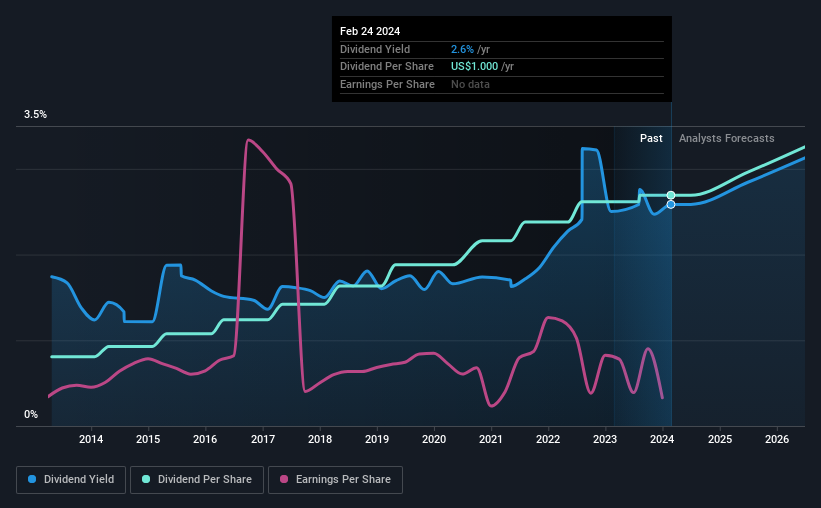Dividend Investors: Don't Be Too Quick To Buy Open Text Corporation (NASDAQ:OTEX) For Its Upcoming Dividend
Readers hoping to buy Open Text Corporation (NASDAQ:OTEX) for its dividend will need to make their move shortly, as the stock is about to trade ex-dividend. Typically, the ex-dividend date is one business day before the record date which is the date on which a company determines the shareholders eligible to receive a dividend. The ex-dividend date is an important date to be aware of as any purchase of the stock made on or after this date might mean a late settlement that doesn't show on the record date. In other words, investors can purchase Open Text's shares before the 29th of February in order to be eligible for the dividend, which will be paid on the 20th of March.
The company's next dividend payment will be US$0.25 per share. Last year, in total, the company distributed US$1.00 to shareholders. Calculating the last year's worth of payments shows that Open Text has a trailing yield of 2.6% on the current share price of US$38.68. Dividends are a major contributor to investment returns for long term holders, but only if the dividend continues to be paid. As a result, readers should always check whether Open Text has been able to grow its dividends, or if the dividend might be cut.
See our latest analysis for Open Text
Dividends are typically paid out of company income, so if a company pays out more than it earned, its dividend is usually at a higher risk of being cut. An unusually high payout ratio of 210% of its profit suggests something is happening other than the usual distribution of profits to shareholders. Yet cash flows are even more important than profits for assessing a dividend, so we need to see if the company generated enough cash to pay its distribution. Fortunately, it paid out only 37% of its free cash flow in the past year.
It's disappointing to see that the dividend was not covered by profits, but cash is more important from a dividend sustainability perspective, and Open Text fortunately did generate enough cash to fund its dividend. If executives were to continue paying more in dividends than the company reported in profits, we'd view this as a warning sign. Very few companies are able to sustainably pay dividends larger than their reported earnings.
Click here to see the company's payout ratio, plus analyst estimates of its future dividends.
Have Earnings And Dividends Been Growing?
Businesses with shrinking earnings are tricky from a dividend perspective. If business enters a downturn and the dividend is cut, the company could see its value fall precipitously. With that in mind, we're discomforted by Open Text's 12% per annum decline in earnings in the past five years. Ultimately, when earnings per share decline, the size of the pie from which dividends can be paid, shrinks.
Many investors will assess a company's dividend performance by evaluating how much the dividend payments have changed over time. In the last 10 years, Open Text has lifted its dividend by approximately 13% a year on average. That's intriguing, but the combination of growing dividends despite declining earnings can typically only be achieved by paying out a larger percentage of profits. Open Text is already paying out a high percentage of its income, so without earnings growth, we're doubtful of whether this dividend will grow much in the future.
To Sum It Up
Has Open Text got what it takes to maintain its dividend payments? It's never great to see earnings per share declining, especially when a company is paying out 210% of its profit as dividends, which we feel is uncomfortably high. Yet cashflow was much stronger, which makes us wonder if there are some large timing issues in Open Text's cash flows, or perhaps the company has written down some assets aggressively, reducing its income. It's not that we think Open Text is a bad company, but these characteristics don't generally lead to outstanding dividend performance.
Although, if you're still interested in Open Text and want to know more, you'll find it very useful to know what risks this stock faces. Be aware that Open Text is showing 5 warning signs in our investment analysis, and 1 of those shouldn't be ignored...
A common investing mistake is buying the first interesting stock you see. Here you can find a full list of high-yield dividend stocks.
Have feedback on this article? Concerned about the content? Get in touch with us directly. Alternatively, email editorial-team (at) simplywallst.com.
This article by Simply Wall St is general in nature. We provide commentary based on historical data and analyst forecasts only using an unbiased methodology and our articles are not intended to be financial advice. It does not constitute a recommendation to buy or sell any stock, and does not take account of your objectives, or your financial situation. We aim to bring you long-term focused analysis driven by fundamental data. Note that our analysis may not factor in the latest price-sensitive company announcements or qualitative material. Simply Wall St has no position in any stocks mentioned.

